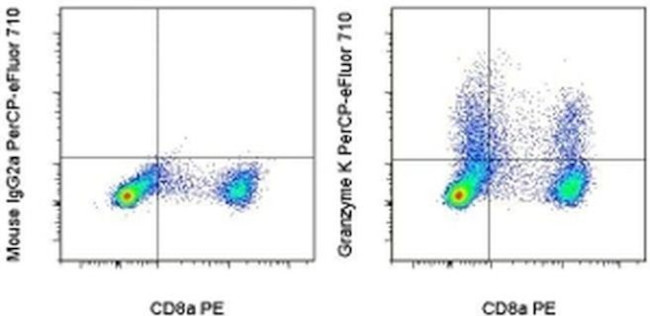Search Thermo Fisher Scientific
Invitrogen
Granzyme K Monoclonal Antibody (G3H69), PerCP-eFluor™ 710, eBioscience™
FIGURE: 1 / 1
Granzyme K Antibody (46-8897-42) in Flow

Product Details
46-8897-42
Species Reactivity
Published species
Host/Isotype
Recommended Isotype Control
Class
Type
Clone
Conjugate
Excitation/Emission Max
Form
Concentration
Purification
Storage buffer
Contains
Storage conditions
Shipping conditions
RRID
Product Specific Information
Description: This G3H69 monoclonal antibody reacts with human Granzyme K. Granzyme K is one of five granzyme serine proteases that have been identified in humans. These proteins are expressed in the granules of NK cells and cytotoxic T cells, and are critical for the induction of target cell apoptosis through the cleavage of intracellular substrates. Granzyme A and Granzyme K are both tryptases and appear to show overlapping, though not identical, substrate specificity. This functional similarity is believed to account for the minimal decrease in cytotoxicity of Granzyme A-deficient CTLs.
Applications Reported: This G3H69 antibody has been reported for use in intracellular staining followed by flow cytometric analysis.
Applications Tested: This G3H69 antibody has been pre-titrated and tested by intracellular staining followed by flow cytometric analysis of normal human peripheral blood monocytes. This can be used at 5 µL (0.03 µg) per test. A test is defined as the amount (µg) of antibody that will stain a cell sample in a final volume of 100 µL. Cell number should be determined empirically but can range from 10^5 to 10^8 cells/test.
PerCP-eFluor® 710 emits at 710 nm and is excited with the blue laser (488 nm); it can be used in place of PerCP-Cyanine5.5. We recommend using a 710/50 bandpass filter, however, the 695/40 bandpass filter is an acceptable alternative. Please make sure that your instrument is capable of detecting this fluorochrome.
Fixation: Samples can be stored in IC Fixation Buffer (Product # 00-822-49) (100 µL cell sample + 100 µL IC Fixation Buffer) or 1-step Fix/Lyse Solution (Product # 00-5333-54) for up to 3 days in the dark at 4°C with minimal impact on brightness and FRET efficiency/compensation. Some generalizations regarding fluorophore performance after fixation can be made, but clone specific performance should be determined empirically.
Excitation: 488 nm; Emission: 710 nm; Laser: Blue Laser.
Filtration: 0.2 µm post-manufacturing filtered.
Target Information
Granzyme K (GrK) belongs to a family of trypsin-like serine proteases localised in the cytotoxic granules of activated T cells and NK cells. It encodes a 28 kDa serine protease whose gene is located on chromosome 5q11-12 close to the granzyme A-encoding gene. Like granzyme A, it has a trypsin-like specifity cleaving at the basic residues arginine and lysine. Granzyme K triggers rapid cell death independently of caspase activation with single-stranded DNA nicks and is primarily expressed in thymus, lung, spleen and peripheral blood leukocytes.
For Research Use Only. Not for use in diagnostic procedures. Not for resale without express authorization.
How to use the Panel Builder
Watch the video to learn how to use the Invitrogen Flow Cytometry Panel Builder to build your next flow cytometry panel in 5 easy steps.
Bioinformatics
Protein Aliases: Fragmentin-3; granzyme 3; Granzyme K; granzyme K (granzyme 3; tryptase II); granzyme K (serine protease, granzyme 3; tryptase II); Granzyme-3; GrK; NK-Tryp-2; NK-tryptase-2; tryptase II
Gene Aliases: GZMK; TRYP2
UniProt ID: (Human) P49863
Entrez Gene ID: (Human) 3003

Performance Guarantee
If an Invitrogen™ antibody doesn't perform as described on our website or datasheet,we'll replace the product at no cost to you, or provide you with a credit for a future purchase.*
Learn more
We're here to help
Get expert recommendations for common problems or connect directly with an on staff expert for technical assistance related to applications, equipment and general product use.
Contact tech support

